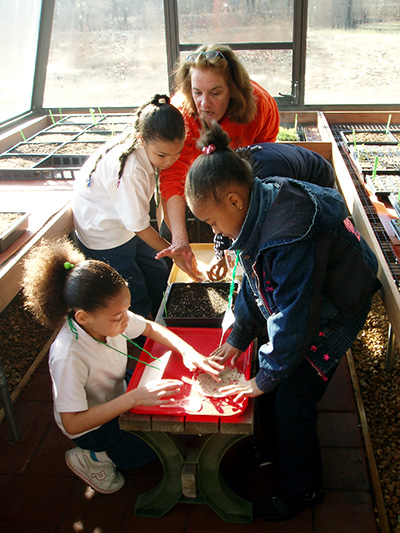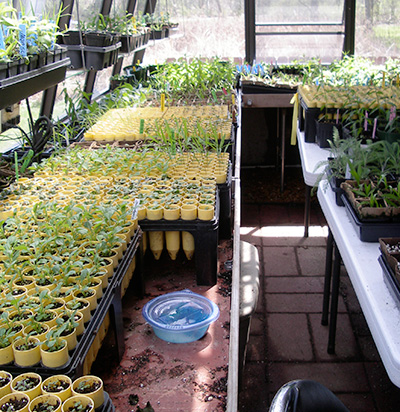Seeds and Propagation
Following a burn, we restore native species by sowing native seeds or by propagating native plants in the greenhouse and transplanting them into the area. Burning the prairie or woodland prepares the soil for seed germination by allowing the seed to directly contact the soil, by warming the soil, and by returning the nutrients of the standing dead biomass to the soil. We focus most of our seeding efforts on areas where we eliminated invasive species or are trying to control the spread of invasive species, new areas of restoration on the site, and the portions of the woodland that have been flooded or are prone to flooding.
Seeds
We collect native seeds by collecting mature seed heads or pods of a desirable plant species and putting them in paper bags between April and November every year from the prairie and woodland at LREC and from similar prairies and woodlands in a radius of about 50 miles around our site.

We try to collect seeds nearby our site in similar habitats to our site so that the species will be well-adapted to the climate present at LREC and will thrive here. We sow seeds collected from spring woodland flowers as soon as they are collected. For summer-collected seed from the prairie and woodland, we first spread the seeds we collect out to dry. We then clean the seed by removing it from the pods, seed heads, fruits, or other unwanted chaff to improve seed-soil contact, to better estimate the amount of seed we have available, and to reduce our seed storage needs. Seed cleaning is a very labor-intensive process, requiring the work of staff, volunteers, and school children.
We store seed in the refrigerator to mimic the cold conditions of winter seed experiences. Some of this seed we propagate so that we will have plants of some species available for children to plant and to increase the survivorship and display of these species. Some of the seed we weigh and combine in seed mixes of many species designed for the soil, water, and light conditions of particular locations at LREC. These seed mixes are sown by hand on newly burned areas or bare areas in the fall or winter.
Propagation of Plants

Propagation of native plants can be achieved in many ways. As mentioned above, seeds can be sown directly on the ground, where nature takes the lead in seed development. Other means of plant propagation include storing seed till sowing time (usually January through March), then sowing in flats under certain heat and light conditions, imitating spring. After the plants have grown to a certain stage, they are transplanted into individual containers where they are cared for until planting time.
Another way is to do a cutting of a plant, where new growth is put into a well-drained medium, sometimes using a rooting hormone to speed root growth. This method is especially effective on woody plants. Other means include grafting and root and leaf cuttings.
Many factors influence the viability of seeds. Some seeds are unusable due to insect infestation or inadequate moisture during seed maturation. Some plants will seed heavily one year and barely at all the next year. We observe nature to learn how, what, where and why propagation works and try to duplicate its success.